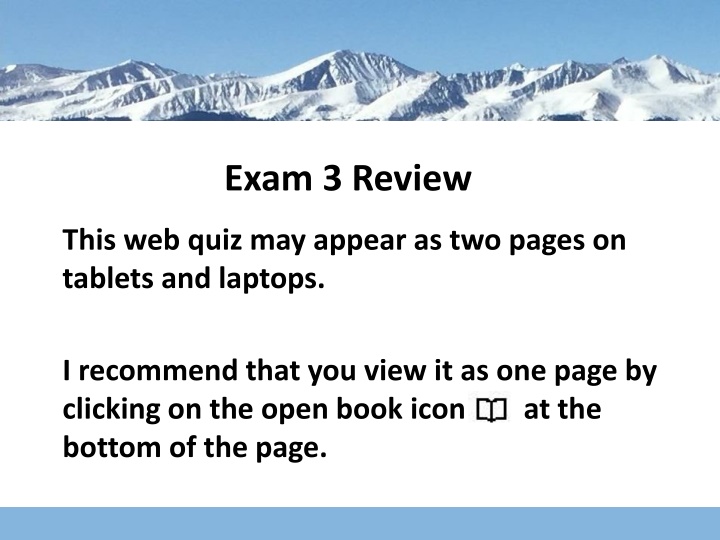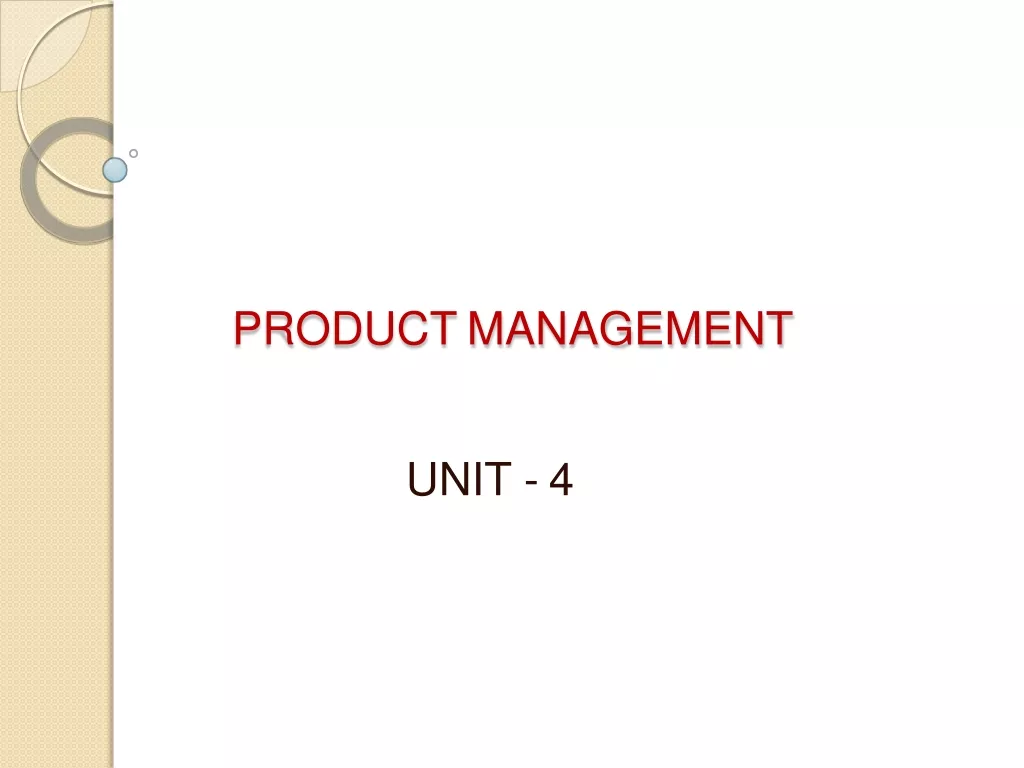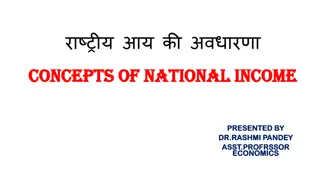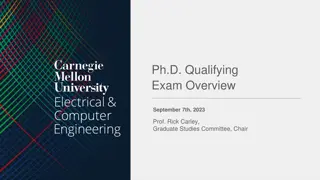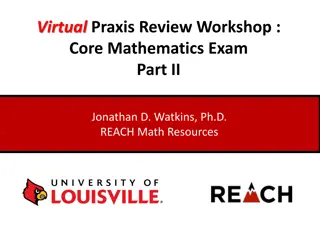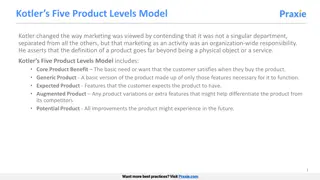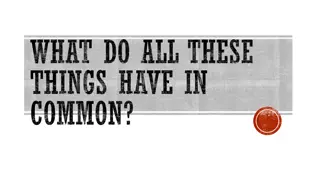Exam 3 Review - Product Market Models & Study Ideas
This exam review covers the Four Product Market Models, study ideas, and tips for each market model. It includes advice on understanding characteristics, demand curves, equilibrium, efficiency, and more. Prepare for your exam by studying vocabulary, practicing problems, and reviewing key concepts.
Download Presentation

Please find below an Image/Link to download the presentation.
The content on the website is provided AS IS for your information and personal use only. It may not be sold, licensed, or shared on other websites without obtaining consent from the author.If you encounter any issues during the download, it is possible that the publisher has removed the file from their server.
You are allowed to download the files provided on this website for personal or commercial use, subject to the condition that they are used lawfully. All files are the property of their respective owners.
The content on the website is provided AS IS for your information and personal use only. It may not be sold, licensed, or shared on other websites without obtaining consent from the author.
E N D
Presentation Transcript
Exam 3 Review This web quiz may appear as two pages on tablets and laptops. I recommend that you view it as one page by clicking on the open book icon at the bottom of the page.
Exam 3 Covers: The Four Product Market Models: Pure Competition - Chapters 8 and 9 Monopoly - Chapter 10 Monopolistic Competition - Chapter 11 Oligopoly - Chapter 11 Be sure to see the exact textbook pages listed on our LESSONS page. PLUS: 5 questions from unit 1 5 questions from unit 2
Exam 3 Covers: Plus: 5 questions from unit 1 Probable topics: 5Es, Benefit Cost Analysis, PPC, gains from trade, determinants of demand and supply, negative or positive externalities, public goods 5 questions from unit 2 Probable topics: price elasticity of demand, price elasticity of supply, determinants of price elasticity of demand, price elasticity and total revenue, graph TU and MU, utility maximizing rule, graph TP, MP, and AP, long- run ATC For ALL graphs: Define, Draw, Describe Shape
Exam 3 Review For Each Market Model Know: 1. Characteristics and Examples 2. Nature of the Demand Curve 3. Short Run Equilibrium (3 graphs and 3 ways) [Don t forget the TR and TC graphs] 4. Long Run Equilibrium and Efficiency Find profit max Q Find alloc. Eff. Q Find prod. Eff. Q 5. Other Issues .
Exam 3 Review Study Ideas: Learn the vocabulary see the Quizlet Flashcards For each graph (each line on a graph): Define Draw Describe the shape Draw graphs don t just look at them Know well the Three Rules and Four Models handout Don t just memorize; try to understand examples
Exam 3 Review Study Ideas DO PROBLEMS/ See Bb: Yellow Pages (answers on Bb) Required Activities (always click submit ) Pre-Quizzes (again, via gradebook) Clicker Quizzes (again) Other Review (online quizzes) Practice Exercises
Exam 3 Review Study Ideas: Do you understand each of the Outcomes listed on our LESSONS page?
REVIEW: BCA Benefit Cost Analysis (MB = MC) To make the best decision: Select all possible alternatives where the marginal benefits are greater than the marginal costs. select ALL possible options up to where MB = MC this implies ignoring sunk (fixed) costs select all where: MB > MC up to where: MB = MC but never where: MB < MC
REVIEW: BCA Benefit Cost Analysis (MB = MC) Always ask: What are the extra benefits and what are the extra costs? If the extra benefits (MB) are greater than the extra costs (MC) then you will gain by doing it. Keep doing it as long as MB > MC up to where MB = MC ignore fixed or sunk costs (ignore costs that do not change as a result of the decision)
1. How many days to ski (using BCA): 1. 1 2. 2 3. 3 4. 4 5. 5
1. How many days to ski (using BCA): 1. 1 2. 2 3. 3 4. 4 5. 5
REVIEW: BCA Benefit Cost Analysis (MB = MC)
REVIEW: BCA Allocative Efficiency Using BCA To find the best quantity for society: MSB = MSC
REVIEW: BCA Three ways to find the Allocatively Efficiency Quantity: (Three ways to find the best quantity for society) P = MC MSB = MSC Maximum producer plus consumer surplus
2. How many to buy (using BCA): Price of skiing = $2 Price of movies = $1 Income = $10 1. 2 skiing and 6 movies 2. 3 skiing and 4 movies 3. 4 skiing and 2 movies 4. 5 skiing and 0 movies
2. How many to buy (using BCA): Price of skiing = $2 Price of movies = $1 Income = $10 1. 2 skiing and 6 movies 2. 3 skiing and 4 movies 3. 4 skiing and 2 movies 4. 5 skiing and 0 movies
REVIEW: BCA How many to buy? MB = MC MUa/Pa = MUb/Pb = MUc/Pc = . . . MB skiing = MC skiing MB skiing is the MU skiing MC skiing is the MU missed from not going to movies BUT: Price skiing = $2 and Price movies = $1 We can t compare a $2 skiing with a $1 movie
3. How many to produce (using BCA): 1. 1 2. 2 3. 3 4. 4 5. 5
3. How many to produce (using BCA): 1. 1 2. 2 3. 3 4. 4 5. 5
REVIEW: BCA How many to produce? (MR = MC)
4. How many to hire (using BCA): 1. 1 2. 2 3. 3 4. 4 5. 5 wage = $12 price of product = $2
4. How many to hire (using BCA): 1. 1 2. 2 3. 3 4. 4 5. 5 wage = $12 price of product = $2
REVIEW: BCA PREVIEW: How many to hire? (MRP = MRC) (MB = MC)
5. Which is NOT a characteristic of pure competition? 1. Very many firms 2. Price takers (no control over price) 3. Standardized product 4. High Herfindahl index 5. No barriers to entry 6. No non-price competition
5. Which is NOT a characteristic of pure competition? 1. Very many firms 2. Price takers (no control over price) 3. Standardized product 4. High Herfindahl index 5. No barriers to entry 6. No non-price competition
6. Which is NOT a characteristic of monopolies? 1. Single firm 2. A lot of control over price 3. Mutual interdependence 4. Unique product 5. Blocked entry 6. Public relations non-price competition
6. Which is NOT a characteristic of monopolies? 1. Single firm 2. A lot of control over price 3. Mutual interdependence 4. Unique product 5. Blocked entry 6. Public relations non-price competition
7. Which is not a characteristic of monopolistic competition? 1. Many firms 2. Standardized product 3. Some control over price (market power) 4. Low barriers to entry 5. A lot of non-price competition
7. Which is not a characteristic of monopolistic competition? 1. Many firms 2. Standardized product 3. Some control over price (market power) 4. Low barriers to entry 5. A lot of non-price competition
8. Which is not a characteristic of oligopolies? 1. Few firms 2. Standardized or differentiated products 3. Blocked entry 4. Mutual interdependence 5. Collusion possible
8. Which is not a characteristic of oligopolies? 1. Few firms 2. Standardized or differentiated products 3. Blocked entry 4. Mutual interdependence 5. Collusion possible
9. Which of the following is a good example of a purely competitive industry? 1. A fast-food restaurant 2. A soft drink company 3. A local electric company 4. A construction firm 5. Agriculture
9. Which of the following is a good example of a purely competitive industry? 1. A fast-food restaurant 2. A soft drink company 3. A local electric company 4. A construction firm 5. Agriculture
10. Which of the following is a good example of a monopoly? 1. A fast-food restaurant 2. A soft drink company 3. A local electric company 4. A construction firm
10. Which of the following is a good example of a monopoly? 1. A fast-food restaurant 2. A soft drink company 3. A local electric company 4. A construction firm
11. Which of the following is an example of a monopolistically competitive industry? 1. Wheat farming 2. Cable TV 3. Automobiles 4. Restaurants
11. Which of the following is an example of a monopolistically competitive industry? 1. Wheat farming 2. Cable TV 3. Automobiles 4. Restaurants
12. Which of the following is an example of an oligopolistic industry? 1. Wheat farming 2. Electric utility 3. Automobiles 4. Restaurants
12. Which of the following is an example of an oligopolistic industry? 1. Wheat farming 2. Electric utility 3. Automobiles 4. Restaurants
13. If P = $32, this competitive firm will produce: 1. 2. 3. 4. 6 7 8 9
13. If P = $32, this competitive firm will produce: 1. 2. 3. 4. 6 7 8 9
14. If the market price for the firm's product is $13, the competitive firm will produce: 1. 5, loss = $105 2. 5, profit = $105 3. 8, loss = $136 4. zero, loss = $100
14. If the market price for the firm's product is $13, the competitive firm will produce: 1. 5, loss = $105 2. 5, profit = $105 3. 8, loss = $136 4. zero, loss = $100
15. What are this firm s economic profits? 1. $65 2. $1500 3. $5000 4. $6500
15. What are this firm s economic profits? 1. $65 2. $1500 3. $5000 4. $6500
16. What are the max. profits possible? 1. fecb 2. fbag 3. 0ecn 4. 0fbn
16. What are the max. profits possible? 1. fecb 2. fbag 3. 0ecn 4. 0fbn
17. For a perfectly competitive FIRM, why is the demand curve perfectly elastic? 1. The firms must lower its price in order to sell more 2. When a firm lowers its price it must lower it on ALL that it sells 3. Because entry is blocked 4. The firm only sells a small fraction of the total sales in the industry
17. For a perfectly competitive FIRM, why is the demand curve perfectly elastic? 1. The firms must lower its price in order to sell more 2. When a firm lowers its price it must lower it on ALL that it sells 3. Because entry is blocked 4. The firm only sells a small fraction of the total sales in the industry
